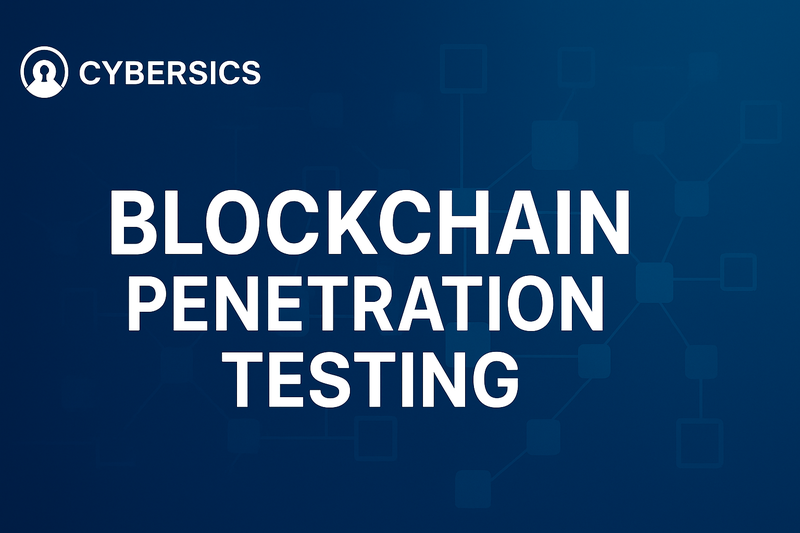Blockchain Penetration Testing: Fortifying Your DApp, Smart Contract, and DLT Security in 2025
3
0
·
2025/08/19
·
5 mins read
☕
WriterShelf™ is a unique multiple pen name blogging and forum platform. Protect relationships and your privacy. Take your writing in new directions. ** Join WriterShelf**
WriterShelf™ is an open writing platform. The views, information and opinions in this article are those of the author.
Article info
Tags:
Total: 1201 words
Like
or Dislike
More to explore










Considering that you've just launched your brand new blockchain application and your DApp has gone live, users are finding their way in, tokens are being traded, and then out of nowhere, an attacker drains your smart contract. That sounds dramatic, but we know from experience that it has happened to some of the largest DeFi platforms.
That's where blockchain penetration testing comes in. It is unique from traditional security assessments in that you simulate a real-world cyber attack against decentralized networks, smart contracts, or DLT-based systems.
However, the issue is that the majority of blockchain penetration testing guides available online are usually too concise (i.e., they cover "what it is" in three short sentences) or too broad (i.e., they only mention Ethereum and the focus is rarely, if at all, on wallets, nodes, or consensus).
This is the value of this guide. We will go over smart contract auditing, DApp penetration testing, cryptocurrency security audit, Web3 security testing, blockchain vulnerability assessment, and anything else relevant to the most searched PAA questions.
What Is Blockchain Penetration Testing?
Blockchain penetration testing is a systematic process for discovering vulnerabilities within blockchain ecosystems. It is not just an organized method to search for bugs; it simulates how a malicious actor exploits:
Smart contracts with reentrancy and/or integer overflow bugs
Consensus mechanisms (PoW, PoS) that are exploitable through a 51% or a Sybil attack
Wallets with poor security issues, like bad key management
Nodes that have been misconfigured and exposed to a DDoS attack
DeFi Applications with weak tokenomics security
Unlike centralized applications that have bug patches pushed within weeks, blockchain bugs are eternalized since you can never go back and fix them. This is why testing upfront is non-negotiable.
Why Is Blockchain Security So Important?
Hackers do not have to think twice when there are billions of dollars in decentralized ecosystems. And for this reason is why blockchain security is extremely important:
Immutability, a double-edged sword – bugs remain forever.
DeFi just multiplied threats – complex protocols + liquidity pools worth thousands of dollars = attackable target.
Ethereum security issues – solidity contracts, with embedded bugs, will lack security.
Tokenomics security – reward systems will be developed in a manner they can be exploited economically.
Node security – hacked nodes putting consensus and credibility at risk.
Traditional cybersecurity blogs will say "audit your smart contract!" but true resiliency involves examining the entire ecosystem from cryptography to consensus.
What Are The 5 Penetration Tests?
This is a popular query that comes up in the PAA. When talking about blockchain, these five penetration tests are the most relevant:
Network Testing – Tests whether there is exposure to a DDoS attack, Sybil attacks, and a 51% attack.
Testing Smart Contracts – Tests for flaws such as reentrancy, unchecked gas limit usage, and integer overflows.
Wallet Testing – Tests for private key safety, private key storage, and signing with sufficient strength.
Node Security Testing – Tests peer-to-peer protocols, RPC exposure, and node configuration.
Stress Tests of Consensus Mechanism – Tests the economic incentives in a work/stake proof mechanism against any manipulation.
What Are the Three Types of Penetration Testing?
Penetration testing is usually defined by three types of penetration testing, and blockchain can adapt to them easily:
Black-Box – Simulates an outsider unwilling to share if they know anything about the company or system; useful for DApp penetration testing.
White-Box – Involves full access to the source code and serves its purpose when auditing smart contracts and looking at a comprehensive blockchain vulnerability.
Grey-Box – Holds a partial insider view; seen often through cryptocurrency security audits, as clients will provide knowledge of APIs but will not provide the entirety of the code base.
What Are the 7 Steps of Penetration Testing?
So, many other competitor blogs miss the boat here in that they neglect an important part of the job: the methodology. And so here is the full cycle:
Reconnaissance – Understand what blockchain type, node architecture, and Solidity version the app is using.
Threat modeling – Determine threats: reentrancy, DDoS, integer overflows, exploits involving the tokenomics.
Vulnerability identification – Run your static/dynamic analysis tools (Mythril, Slither, Oyente).
Exploitation – Be an attacker, conduct Sybil attacks, provoke consensus manipulation, prey on wallets.
Post-exploitation analysis – Determine how much damage was done (loss of funds, chain splits, inflation of tokens, etc.).
Reporting & fixes – Disseminate issues with mitigation options.
Re-testing & Monitoring – Ensure that patches worked and have a plan for continuous Web3 security testing.
What Is Blockchain Cybersecurity?
At its essence, blockchain cybersecurity is about protecting decentralized networks against threats, in every layer of the technology – from contracts, to nodes, wallets, consensus, and cryptography. It employs penetration testing, monitoring, and compliance.
Think of it as the blockchain world’s immune system, where we are able to protect the integrity, confidentiality, and availability of both data and assets.
Advanced Areas Typically Missed In Other Blogs
To truly beat SERP rivals, let’s dive into areas they typically miss:
Cryptography – Testing the key generation, storage mechanisms, and robustness of hash functions.
Solidity Language Security – Assurance against breaking common patterns, beyond simple security testing to advanced programming logic bugs.
DeFi Protocol Stress Testing – Test for draining liquidity pools, and testing for flashloan exploits.
Tokenomics Security – Test against financial attack vectors, ensuring that the rules of token supply and incentive/reward cannot be gamed.
Cross-chain Bridges – One of the biggest attack surfaces in 2025, not often mentioned in previous blogs or whitepapers.
Just a Quick Real-Life Example
A DeFi startup scanned its code and thought everything was fine. But in a grey-box test, an auditor created a Sybil attack, which revealed that price oracles could have been impeded by overwhelming nodes. If this hadn’t been found, millions in user funds could have been mis-priced.
This shows the difference between superficial checks and thorough blockchain penetration testing.
Engaging with the Experts (here's where CYBERSICS comes in)
If you lack the relevant in-house expertise, working with professionals can make or break your project’s security. CYBERSICS provides contemporary, adaptive, flexible solutions for organizations that manage critical or sensitive systems—including blockchain ecosystem exchanges.
As one of the trusted Cyber Security Service Providers, they assist with risk assessment, vulnerability remediation, and network hardening without engaging to large measures of complexity. Whether you are executing a DeFi protocol, designing and building a private distributed ledger technology (DLT), testing Ethereum smart contracts, or simply looking for some incidental value, using CYBERSICS will always provide a safety net.
Final Thoughts
The blockchain ecosystem moves with extreme rapidity, and attackers do as well. By conducting smart contract auditing, DApp penetration and testing, cryptocurrency security audits, Web3 security assessments, and vulnerability assessments at the blockchain level, you can use proactive measures to avoid scrambling for answers to a breach.
This blog is intended to provide a holistic answer to possessive applicable actions (PAAs), provide some level of technical depth (e.g., consensus, encryption, and tokenomics), and human-dependent answers where other guides miss the mark.
If you take away one thing? Don't take chances on the security of your blockchain ecosystem. Audit, re-audit, and if you are concerned, call in experts like CYBERSICS to help you maintain a resilient ecosystem.